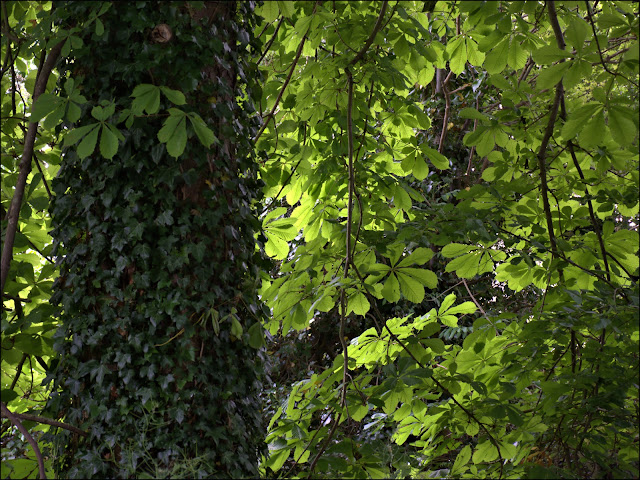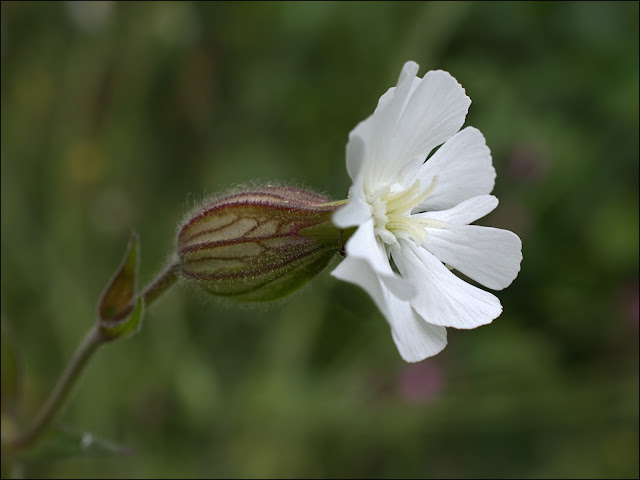One afternoon, some years ago, I fell into conversation with an elderly gent out walking his rather reluctant dog. Somehow he ended up telling me about some houses that used to stand among the nearby fields, some distance from any road and only reachable on foot. "All gone long ago", he added.
When I got home I found some old maps online and there they were on the 1901 map, perhaps ten cottages in what were now agricultural fields. Of course I couldn't stop there; I had to comb the map for more forgotten details. I found that a track that I follow regularly was known as Huckles Lane. Maybe some locals still use the name, I don't know.
It's hardly a lane any more, and nobody now uses it to reach any isolated dwellings, but it's still a right of way for walkers, so it just about remains open.
If this little caterpillar and his mates have their way the encroaching vegetation will have a fight on its hands. This is the caterpillar of the Ermine Moth. They cover trees and bushes with this cobwebby material to discourage birds from feeding on them, then proceed to strip the tree of its foliage. This particular type feeds on Spindle trees and, devastating though it appears, the trees usually recover and grow new leaves later in the year.
There's a wide variety of trees along here which usually indicates an ancient hedgerow. That's pretty much what I'd expect; the Huckles (or Huckyls) lived in the village back in the thirteenth century. Perhaps they had a farm down here. Anyway their name was patiently passed down through generations of farmers - "George, take they sheep down Huckles Lane to graze on the moor".
And there are still sheep to be found grazing on the moor every summer. That sign, blowing in the wind on the side gate, says as much - "Dog owners, the sheep are back, keep your dog on a lead".
Another of the fields just off the lane contains a field of flax this year. It's probably being grown for its seeds containing linseed oil, which is nowadays is mostly used in the food industry.
It forms a smoky blue background for this fieldside poppy.
But this is where the old cottages once stood. This year it seems to have been left fallow, and wildflowers are springing up all over.
Although it wasn't my aim when I set out this morning, I couldn't resist following the footpath around the perimeter of the field.
I had no intention of tramping all over the field, even though it's not in full production this year; once one person does it then others follow and soon it becomes a complete mess. Instead I used a long lens, which I hope gave me some of the dreamy, impressionistic look that I was after.
Then I was off down the lane again, in the footsteps of ploughmen, shepherds, cottagers, blackberry-pickers and the old chap who was, a few years back, walking his reluctant dog.
Take care.
















So much history. Thank you John. Lovely photos and information as always.
ReplyDeleteYou discovered old England, those wild flowers are absolutely stunning, as is the camera work! No tell tale signs of foundations I wonder, its as if the cottages have been completely obliterated.
ReplyDeleteI had a look out there once when the field was ploughed; there were still a few old broken bricks in the soil. There are also daffodils at the field's edge, presumably from the old gardens.
DeleteIf there is a more charming name for a lane than Huckles, I can’t imagine what it is. Your Monet flower capture is a beauty!
ReplyDeleteIf berries grow along Huckles Lane are they huckleberries?
ReplyDeleteI think you found success with your long lens. And I love the single poppy with the blurred background. The path looks like a wonderful one to follow.
ReplyDeleteWonderful post with just the right amount of great information and beautiful photos. Well written, John!
ReplyDeleteOh those wildflower fields - so beautiful John. I'll be arriving in the UK next week and hopefully see similar on my National Express ride from Heathrow to Devon! Also hope someone will take me across Dartmoor whilst home. . . . . .so many childhood country memories there.
ReplyDeleteLovely scenery and great photos as always, thanks.
Very artistic floral photos...love them all! Thanks for the history of Huckles Lane, and I dare say the roots of those trees remember the people from the 13th century, though none of those trees are that old.
ReplyDeleteA timely encounter. Wonderful post, John.
ReplyDeleteWhat a beautiful walk back in time. I love reading of the history there and getting a sense of it through your photos.
ReplyDeleteWhat beautiful wildflowers have been left behind - as for flax - a few years ago one or two farmers round here tried growing a field of flax - all that remain now are a few escapees.
ReplyDeleteHow I love walking with you. Thank you. And your impressionist photos most definitely worked.
ReplyDeleteThat is a pretty walk. It sounds like we are the same in looking at OS maps to find what used to be there.
ReplyDeleteWhat utter delight. You make me feel as though I was there with you. I adore your poppy on a blue ground of flax.
ReplyDeleteI say ditto to all the comments made above. Gratefully yours.
ReplyDeleteBeautiful shots!
ReplyDeleteWonderful history of the land. And then one wonders what else cold have happened.
ReplyDeleteFascinating history!
ReplyDeleteI love your photos of the flowers alongside the history of the area.
ReplyDeleteAnother lovely walk and so beautiful with the flowers.Interesting history too. Great photos.
ReplyDeleteHi John - this is just beautiful ... loved the history, the beautiful photos ... and can imagine the old man leaning on his stick telling you about the little hamlet out in the fields, now pushing daisies up ... and his dog quiet at the beginning, fretting after a while to get a move on! Flax is such a pretty plant to have in a field, while the poppy stands out - mighty proud. Quite wonderful - thank you - Hilary
ReplyDeleteIt is always amazing to me when I read about places that "once were" and then try to imagine how they might have looked should I be in that area. The wildflowers growing in the field were beautiful but the cottages must have been quite interesting years ago. It's rather nice that there is nothing now in their place. I would have followed that footpath too after hearing the story.
ReplyDeleteThe beautiful floral meadow scenes are amazing John.
ReplyDeleteYou are correct about the Flax.
Wonderful post. I'm intrigued with old maps, and not really sure how to find them (or if they even exist) for my area. Our local deserts get what we call "tent caterpillars" in the bushes. They look very similar to yours. You sure get some beautiful wild flowers!
ReplyDeleteInteresting word 'Huckyls'. I once lived in Duckyls Cottages, near Duckyls Farm, near East Hoathly in Sussex.
ReplyDeleteSo many beautiful flowers. I especially love the color the poppies add to the mix.
ReplyDeleteI just love all the beautiful flowers. I especially love all the poppies. Enjoy your walk, hugs, Edna B.
ReplyDeleteYou have had a beautiful and wonderful walk. Summer is at its most beautiful when all the flowers are in bloom. The red poppy is a lovely flower, we have it not so widely spread. Greetings from orvokki.
ReplyDeleteBeautiful meadows and wonderful photos!
ReplyDelete